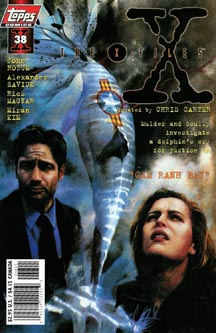In a mystery worthy of an X-File itself, the Topps “X-Files” comics series abruptly ended in September 1998 with Issue 41, in the wake of the popular feature film, as Topps closed the comics wing of the company. Even the editor wasn’t privy to this bombshell, as there’s no mention of it in the last issue’s letters column.
The five issues from 1998 are the typical solid standalones we’ve come to expect from the title – four from John Rozum and one from editor Dwight Jon Zimmerman. His “Devil’s Advocate” (Issue 40) puts him among a quartet to have penned an “X-Files” comic in the regular run, along with Rozum (22 issues), Stefan Petrucha (16 issues) and Kevin J. Anderson (two issues).
Although the mainstream entertainment media – and certainly the mainstream media in general – has an unwritten rule that tie-in materials aren’t to be acknowledged, it’s a testament to how huge “The X-Files” was in the summer of ’98 that Issue 40 was mentioned in my hometown paper, the Forum of Fargo-Moorhead, because it featured a story set in Devils Lake, N.D.
And it’s a juicy one, as Zimmerman imagines the military is hiding nuclear weapons under the overflowing Devils Lake, thus breaking an international treaty. He notes that North Dakota – also featured in the Season 4 episode “Terma,” where Krycek gets locked in a nuclear silo — would be the world’s fourth-largest nuclear power if it seceded from the union. As is often the case, Mulder and Scully know what’s going on, but they leave the site without tangible proof, and thus the government is protected from its own snooping agents. The images of the dead trees in the lake are spot-on, as is the idea that the Army’s work on dams to protect homes would distract the populace from the nuclear cache.
Rozum’s most compelling entry from this batch is “Cam Rahn Bay” (38), in which weaponized dolphins from the Vietnam War are accidentally triggered by cellphone signals. While the things that humans do to other humans during war is horrifying, there’s a particularly unique horror about the US Navy’s Swimmer Nullification Program, which outfitted dolphins with spears to kill enemy soldiers and trained them to plant bombs on enemy vessels. I like that Mulder draws a parallel to the killer ravens from “Skybuster” (34).
“Scum of the Earth” (39) is another environmentally themed story, making it clear that this is a pet interest of Rozum’s – although to his credit, he never gets preachy. In a takeoff on “Flubber,” he invents “blobber,” a bouncy play-dough-style toy that had to be recalled when it gave kids rashes. But the company had a hard time neatly disposing of the substance, and decades later it has taken on a life of its own in the Florida lowlands, killing sewer workers and people who are innocently taking a shower. It’s like if “The Host” (from Season 2) had been an ooze rather than a creature. In another neat nod to continuity, the mad scientist villain from “Surrounded” (30-31) returns.

The other two issues are straight-ahead monster yarns. “Severed” (41) – appropriately titled considering that it marked the abrupt end of the series – is a werewolf tale with an “It Follows” spin: A werewolf can be cured if the werewolf that bit him is killed. And similar to “Buffy’s” werewolf lore, established earlier in 1998, this werewolf has some control over his shapeshifting; it’s not entirely dependent on lunar phases. Considering Rozum’s generally good attention to continuity, it’s surprising that neither Mulder nor Scully reference Season 1’s “Shapes,” which tread very close to being a werewolf story.
Issue 37, which for some reason is untitled, hews closely to Season 1’s “The Jersey Devil.” Whereas that classic episode explored the myth of feral humans living in the New Jersey woods, this issue taps into the Goatman myth of the Maryland woods. Although Scully theorizes that these are genetically abnormal humans, the mythology holds that they are a separate, sentient species that has managed to live on in the woods despite the rise of the human race. In a clever final-panel twist, the goatman aims not to save the last female of his species but rather to kill her so that no more of his race have to live in a world increasingly dominated by humans.
There are no doubt a few Rozum scripts out there that were axed due to the series’ end. (Topps’ other ongoing “X-Files” series, the adaptations of Season One episodes, left “The Jersey Devil” and “Ghost in the Machine” unreleased.) One of the unreleased yarns probably had something to do with crop circles, judging from an inaccurate synopsis of Issue 39 on an advertising page at the back of the comics; a few times over the course of the series, the order of the stories was changed after descriptions went out to advertisers. It would be cool if these unfinished Rozum stories could be uncovered someday by current license-holder IDW. I give a slight edge to the imaginative Petrucha among Topps “X-Files” scribes, but the reliable Rozum is runs a close second.
While this marks the end of the regular Topps series, I’ll be back with a look at the specials, digests and annuals in an upcoming post.

